Peru is a highly popular country for hiking enthusiasts, and it’s not surprising, given its variety of options. While the famous Inca Trail has captivated the world, the Salkantay trek is also gaining prestige as an impressive alternative route to Machu Picchu.
The Inca Trail is globally renowned for its ancient history and fascinating archaeological sites. On the other hand, the Salkantay trek will transport you through stunning landscapes and dreamlike natural settings.
In this article, we will explore both routes, describing the most popular treks to Machu Picchu and analyzing their standout features and differences to help you make an informed decision. Remember that, regardless of your chosen route, you will have an unforgettable experience as you delve into the ancient Incas’ magical world and the Peruvian Andes’ awe-inspiring beauty. Let’s get started!
What is the Salkantay Trek?
The Salkantay Trek to Machu Picchu has become the best alternative to the Inca Trail. It offers an authentic adventure that showcases some of the most astonishing landscapes you will ever see. You will descend from snow-capped peaks to the warm jungle.
Along this route, you will encounter various animals, from alpacas to exotic jungle species and unique flora. You will also pass through small communities and witness how people live in rural regions.
What is the Inca Trail?
The Inca Trail Peru is one of the most renowned routes in the world, and it’s not hard to see why. It combines a historical adventure, visiting ancient ruins, with the feeling of walking on the same paths used by the Incas themselves. These trails once connected the Inca Empire 500 years ago.
You will ascend and descend many steps, stopping at different locations. Throughout the journey, you will be surrounded by the breathtaking Andes and the spectacular wildlife typical of the region. The ascents and descents can be demanding on the legs, so ensure you are well-prepared.
Salkantay Trek vs Inca Trail difficulty
Is the Salkantay trek harder than the Inca Trail? It is a common question among hikers who wish to explore Machu Picchu. Both hikes offer unique trails, but it is essential to consider some factors:
How long is the Salkantay Trail?
The classic Salkantay trek to Machu Picchu typically lasts for 5 days and 4 nights and is considered more challenging regarding distance and altitude. Here, hikers cover approximately 74 kilometers (46 miles) through steep slopes, rocky terrain, and drastic weather changes.
How long is the Inca Trail?
The classic Inca Trail to Machu Picchu lasts for 4 days and 3 nights and has a length of 42 kilometers (26 miles); it is known for its steep trail and stone steps. However, other shorter route options are available, such as the 2-day Inca Trail and other alternative routes that can last up to a week.
Salkantay Trek altitude
The Salkantay Pass is the highest point reached during the Salkantay trek, with an approximate elevation of 4,600 meters (15,190 ft). It is usually encountered on the second or third day of the route.

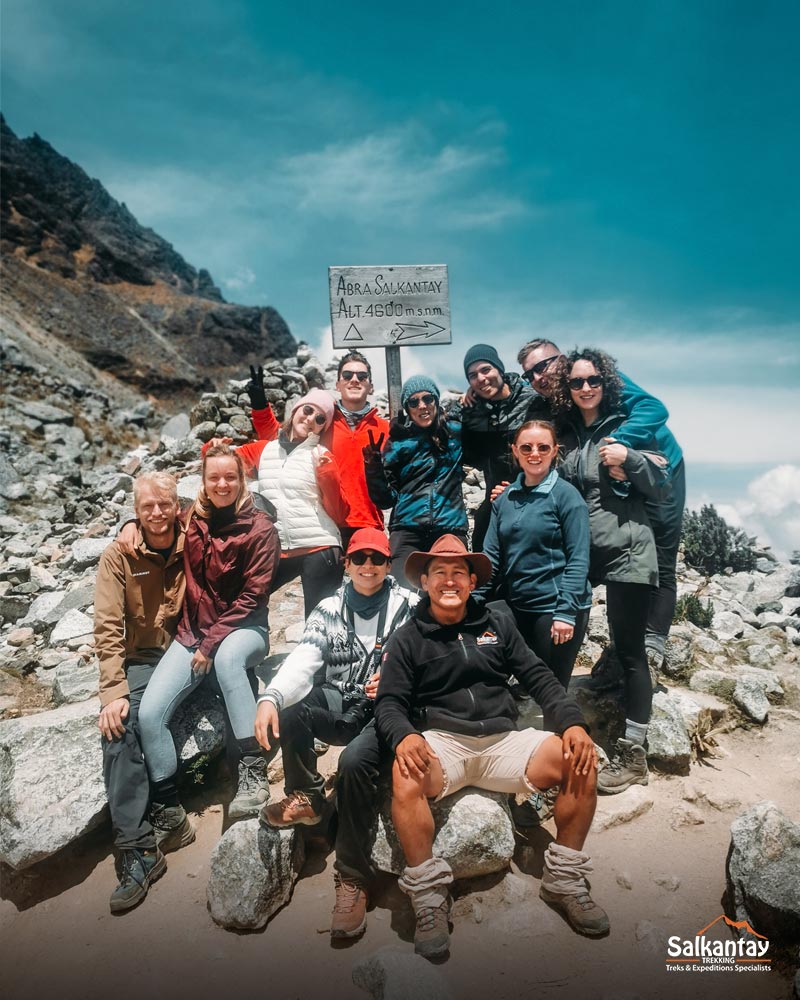
Inca Trail altitude
The Inca Trail elevation, known as the Camino del Inca or Qhapaq Ñan, reaches 4,215 meters (13,829 ft) at its highest point, the Warmiwañusca Pass, also known as the Dead Woman’s Pass. This location is encountered on the second day of hiking from the start of the trail.

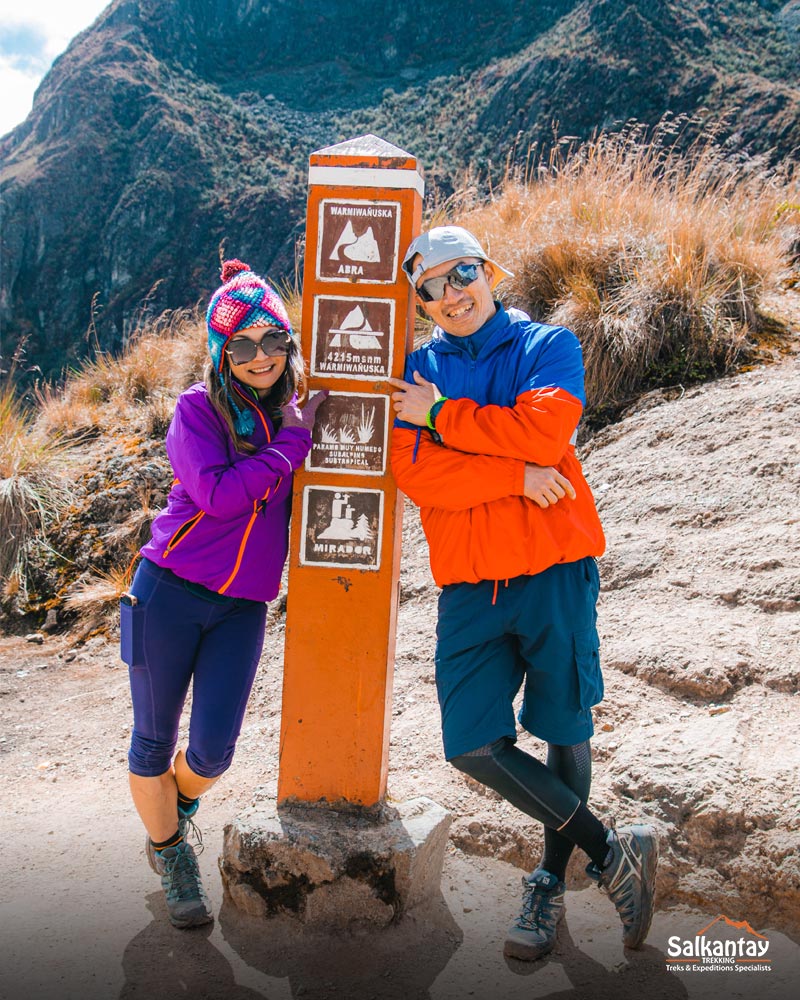
The scenery of Salkantay Trek vs Inca Trail
Salkantay Trail Peru
During the Salkantay trek, you will pass through deep and green valleys. You will visit the magical Humantay Lake, enjoy fantastic views, and traverse a variety of climates, from cold, snowy mountain regions to the humid jungle.
As you approach your final destination, you will appreciate the grandeur of the high jungle and enjoy breathtaking panoramic views. The beauty of the Urubamba River will accompany you throughout your journey. Finally, you will reach Aguas Calientes, the town at the foot of Machu Picchu, and embark on your last adventure by visiting the historic sanctuary.
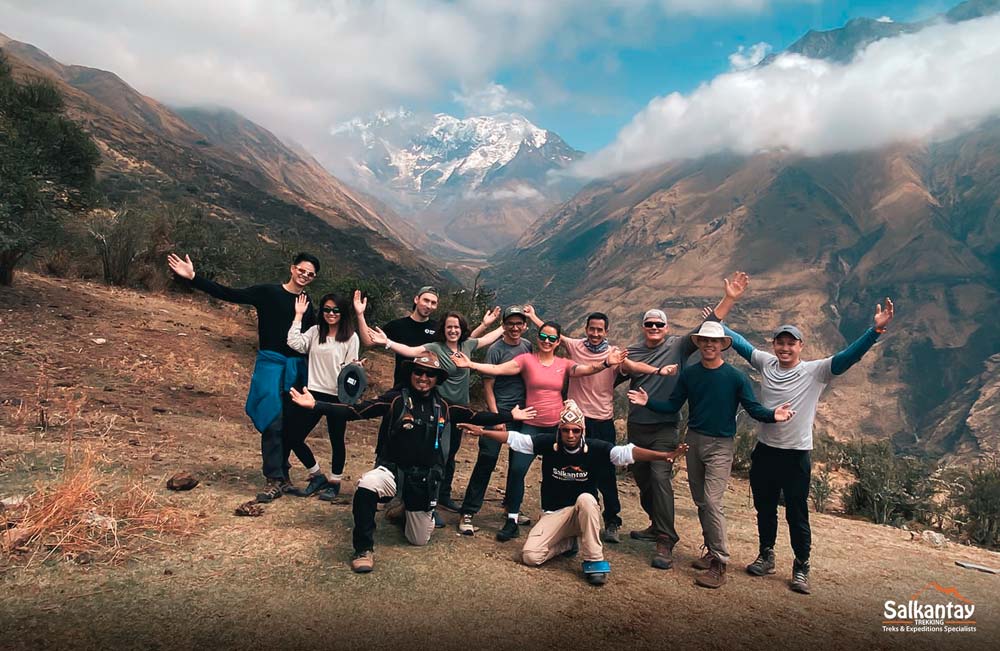
Inca Trail Peru
On the Inca Trail, you will traverse lush tropical jungles and witness diverse and exotic flora and fauna. You will ascend and descend many steps, stopping at different sites.
You will visit amazing archaeological sites and Inca ruins such as Runkurakay, Sayacmarca, Phuyupatamarca, and Wiñay Wayna. However, the highlight comes when you approach the majestic Inca citadel of Machu Picchu through the Sun Gate, known as Inti Punku. From there, you will witness an unparalleled panoramic view of the citadel, with its terraced landscapes and magnificently preserved Inca constructions.

Weather Salkantay Trek vs Inca Trail
Weather in Salkantay Trek to Machu Picchu
The Salkantay Trek weather can vary significantly due to the variety of altitudes and ecosystems in Peru’s Cusco region.
- During the first day of hiking in the Mollepata area, it is usually hot during the day, and temperatures can drop to around 2 degrees Celsius (41 degrees Fahrenheit) at night.
- As you ascend to higher elevations, such as the Salkantay Pass, temperatures drop, hovering around 0 degrees Celsius (32 degrees Fahrenheit).
- In the lower areas near Machu Picchu, such as Santa Teresa and Aguas Calientes, the climate is usually warmer and more humid, with temperatures between 20 and 25 degrees Celsius (68-77 degrees Fahrenheit) during the day, and around 10 degrees Celsius (50 degrees Fahrenheit) at night.
Weather in Inca Trail to Machu Picchu
The Inca Trail weather, as well as the Salkantay trek, may vary:
- During the day, in the lower areas, like the hike’s starting point at Piscacucho (km 82), you can expect warm temperatures ranging between 20 and 25 degrees Celsius (68-77 degrees Fahrenheit).
- As you reach higher areas like the Warmiwañusca Pass, temperatures can drop to around 0 degrees Celsius (32 degrees Fahrenheit) or even lower.
- When you are in places closer to Machu Picchu, such as Wiñay Wayna and Intipunku (Sun Gate), the climate tends to be warmer and more humid, with temperatures ranging between 20 and 25 degrees Celsius (68-77 degrees Fahrenheit).
Where to sleep on the way to Machu Picchu?
Salkantay Trek Campsites
You will spend 3 nights in comfortable accommodations to enjoy the starry sky here. On the final night, you will rest at a hotel in Aguas Calientes before exploring the majestic Machu Picchu. At Salkantay Trekking, we provide the best accommodations for a comfortable stay after a long day of hiking.
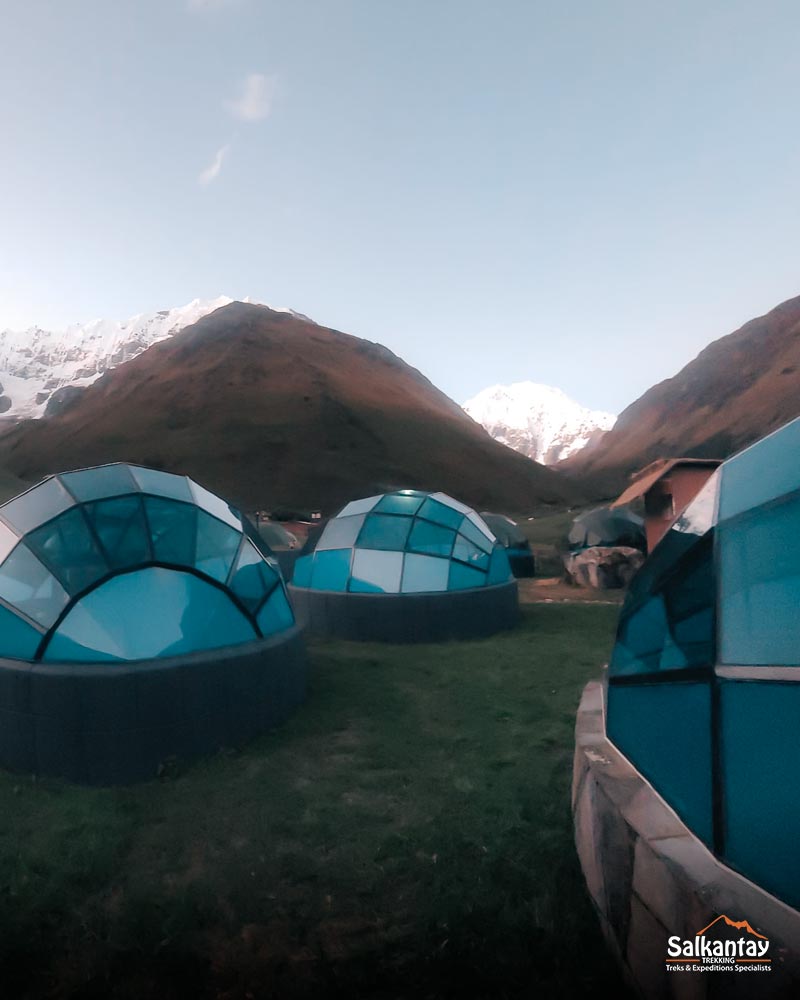
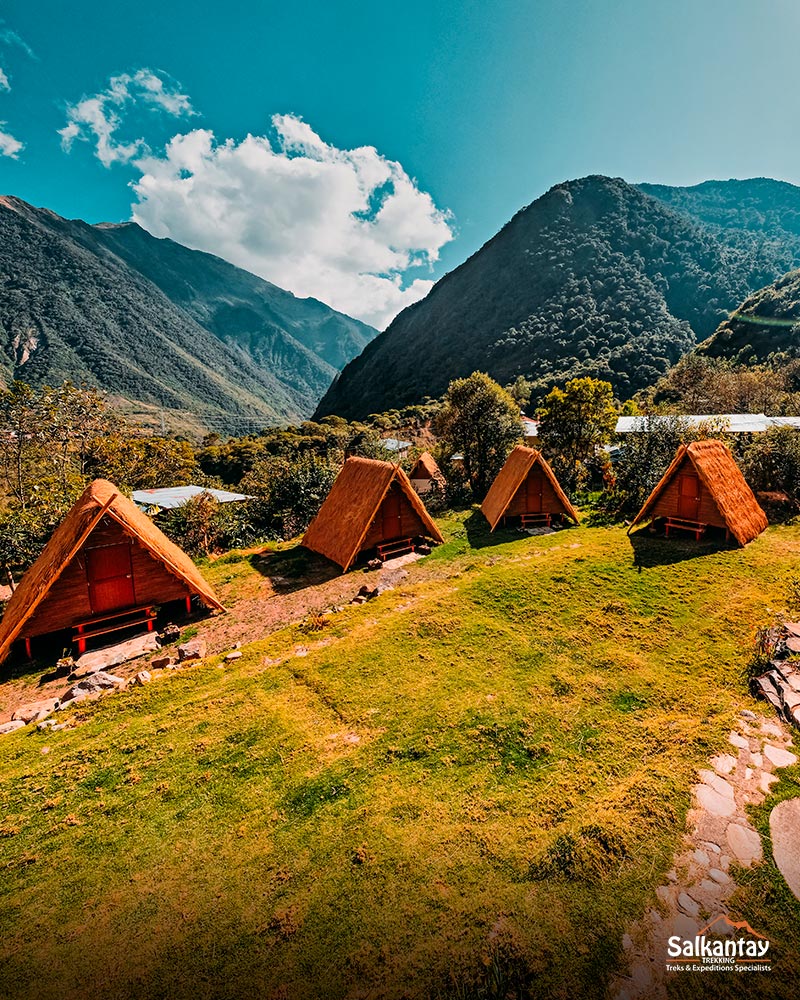
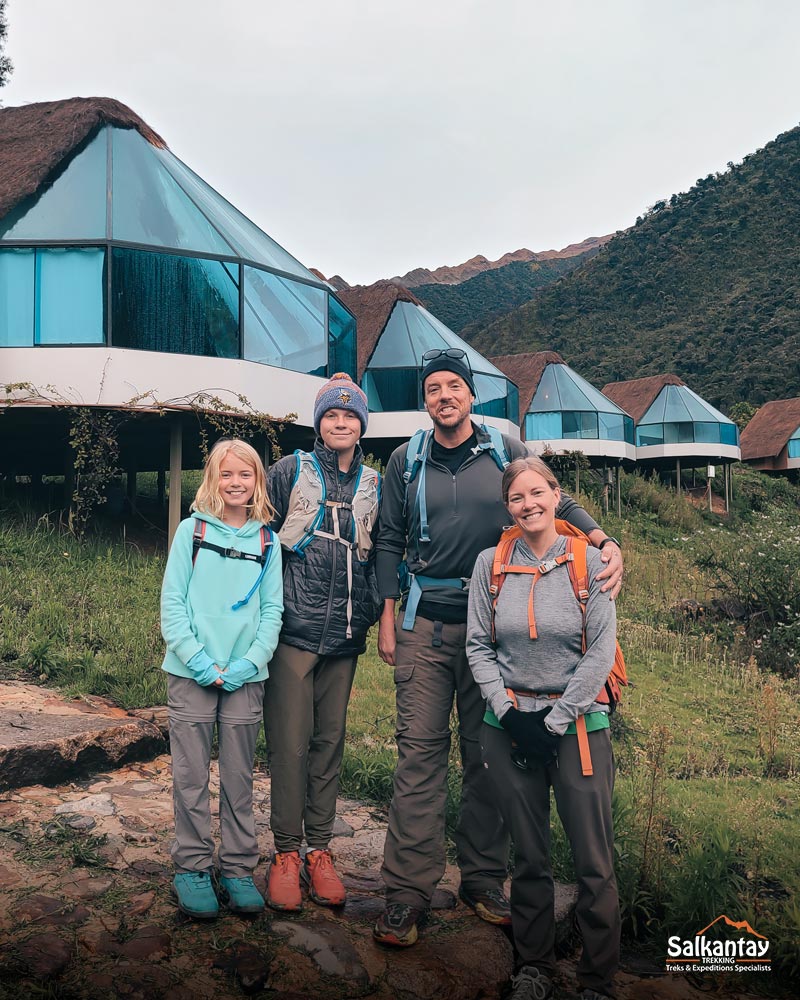

Inca Trail Campsites
During the Inca Trail, you will spend the nights in various campsites with available bathrooms. Along the route, you will have three nights of accommodation in basic but well-provided campsites, where you will find everything you need to rest and have meals.
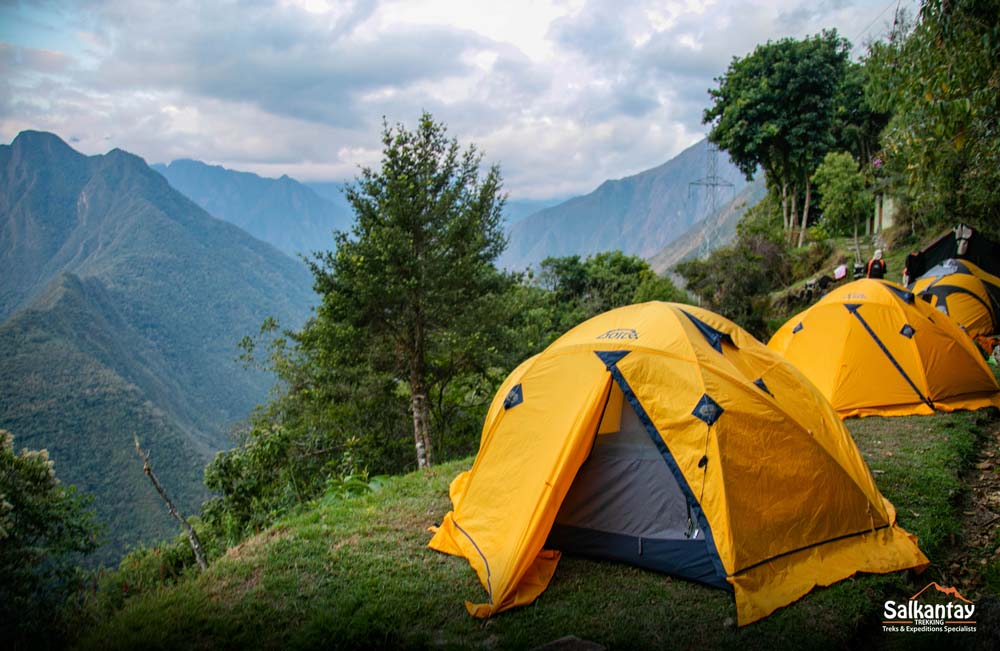
Cost
How much does the Salkantay Trek cost?
Unlike the Inca Trail, the Salkantay trek is less expensive. The average price for a 4 or 5-day Salkantay trek ranges between $500 and $700. At Salkantay Trekking, we offer the Salkantay trek with a guide, camping equipment, meals during the trek, accommodations, and entrance to Machu Picchu.
How much does the Inca Trail cost?
The average cost for a 4-day, 3-night Inca Trail trek is between $600 and $1000 per person. At Salkantay Trekking, we offer the Inca Trail with a guide, round-trip transportation from Cusco to the start of the hike, meals during the journey, camping equipment, and entrance to Machu Picchu.
Salkantay Route and Inca Trail Permits
Salkantay Trail permits
- Entrance ticket to Machu Picchu: You will need an entrance ticket to Machu Picchu to visit the citadel after completing the hike. You can obtain this ticket through the Dirección Desconcentrada de Cultura of Cusco or online through the official Machu Picchu website.
- Tour guide: Although having a tour guide for the Salkantay trek is not mandatory, we recommend hiring one. Guides know the route, provide information about points of interest, and can assist you with any problems or difficulties.
- Travel agency services: Many hikers choose to join an organized tour through a travel agency that offers comprehensive services for the Salkantay trek. These packages often include transportation, accommodation, guides, meals, and other necessary services during the hike.
Inca Trail permits
- Inca Trail permit: This is the primary permit you must obtain to undertake the hike. Please note that limited permits are available daily (200 tickets for general visitors), so we recommend booking in advance.
- Machu Picchu entrance ticket: Similar to the Salkantay trek, this ticket is necessary as it allows you to enter the citadel after the hike.
- Official tour guide: It is mandatory to be accompanied by an official tour guide to undertake the Inca Trail. Your guide will lead the group and provide information about the trail and the archaeological sites you will encounter.
Please be aware that Inca Trail permits sell out quickly, especially during high-demand months such as June, July, and August. We recommend booking for several months to ensure you secure the necessary permits on your desired dates.

So, which one to choose?
Both the Salkantay Trek and the Inca Trail are two of the best routes in the world that will lead you to Machu Picchu. The choice depends on your preferences, available time, and fitness level. Both options will allow you to live a unique experience in the Peruvian Andes. Here, we give you a list of the best routes to Machu Picchu:
Why Choose Salkantay Trail?
There are so many reasons to choose this fantastic route, so we’ve compiled a list to help you decide if this is the one for you.
No need for permits. This means the trek is ‘always available,’ and you don’t need to worry about available spaces. You will, of course, need to check if the tour operator has spaces available.
Incredible scenery. Many say this is the region’s most scenic route, and they’re right. You experience fantastic views and pass through various climates, from cold, snowy mountainous regions to humid jungles.
Humantay Lake. In recent years, this impressive lake has become part of things to do before you die. You can visit it on a day trip, but if you opt for the Salkantay trek, you will visit it on the first day.
More amenities. On the Salkantay trek, you’ll have access to bathrooms and spend the last night in a hotel in Aguas Calientes, meaning you can shower and clean up before going to Machu Picchu.
Fewer tourists. The trail is becoming more popular yearly, but that doesn’t mean it’s as packed as the Inca Trail. You’ll be able to enjoy moments of peace as you walk along the route.
Horses. If you’re finding things tough on the way up to Humantay Lake or the Salkantay Pass, you can hire a horse to take you up. Just be aware that they won’t take you down the other side.
Price. This route is much more economical than the Inca Trail because you don’t need to buy a permit. This makes it more accessible to everyone.
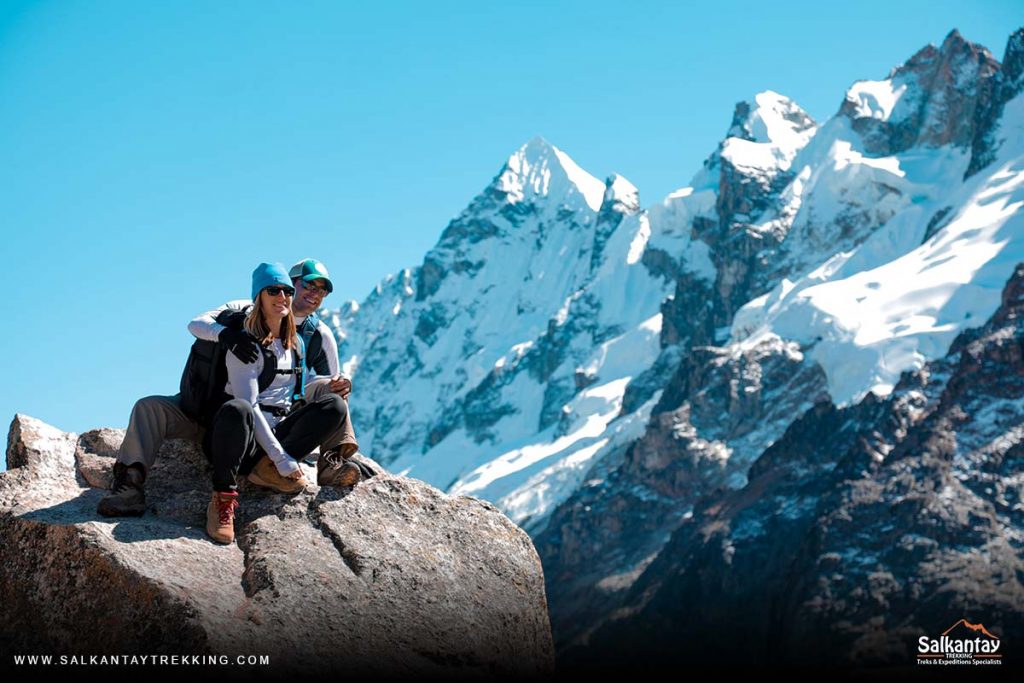
Why Choose the Inca Trail?
There’s no doubt this is a top option for many trekkers coming to Peru, but if you haven’t yet decided, check out our reasons why you should go for the Inca Trail.
Walk along ancient paths. The name is the Inca Trail because you literally walk along the routes of our ancestors. It’s a special feeling knowing this and it takes you back in time to a moment where you can imagine how it was for this ancient civilization.
One of the top treks in the world. The Inca Trail has won many awards, making it one of the most sought-after routes. It’s exciting knowing you’re walking along such a famous trail.
Inca ruins. If you’re a history lover, this trek is for you. You’ll visit many sites that you can only view on this route. It’s an excellent insight into this ancient culture. You’ll learn a lot from your guide about how life was back then and be able to imagine it for yourself as you look out on the sites.
Back to basics. This is a great option if you love roughing it and feeling at home with nature for a few days. There are no real bathrooms or villages to stop at along the way.
Machu Picchu entrance. This is the ONLY trek where you can enter Machu Picchu from the sun gate rather than the main entrance. This is truly a once-in-a-lifetime experience.
Difficulty. The Inca Trail is a little less challenging than the Salkantay Trek. This means it’s a little easier for those who don’t want anything so strenuous. However, this doesn’t mean it’s a simple walk.

The Verdict
Now you know a little about two of the best treks in Peru, Salkantay Trek vs Inca Trail, and the advantages of choosing one or the other. Although we can’t say that one is superior to the other, we can guarantee that you will have a great time, whichever one you choose.
If you like to hike some of the best-known trails in the world and you love to learn about the history of a place, we recommend you choose the Inca Trail. If you prefer a quieter route with fantastic scenery and don’t spend too much, we suggest the Salkantay trek.
Keep in mind that both routes have breathtaking scenery and lessons to learn about the environment and the history of the Incas, they just both offer more in different ways. We wish you all the best with either and know that you will take home some incredible memories in Cusco, Peru that you will treasure for a lifetime.















Leave A Reply